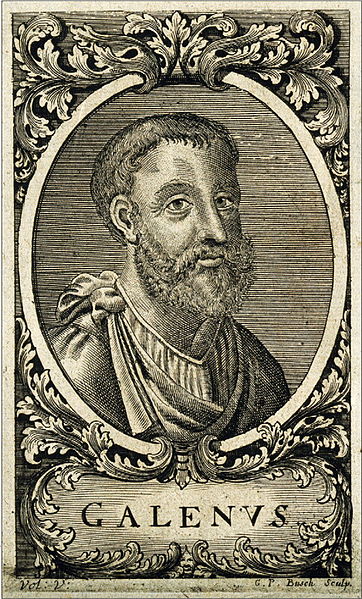World War Two
Published 6 Aug 2021With the scarce food supply brought about by war, many turn to the black market and its astronomic prices as supplements. It is a place for opportunists and patriotic protesters, but mainly it’s a means to survive.
(more…)
August 7, 2021
The Black Markets of World War Two – WW2 – On the Homefront 012
Ancient and medieval medicines
In the latest Age of Invention newsletter, Anton Howes considers the medicinal knowledge of our ancestors and suggests that the mockery we usually heap on them is at least somewhat misplaced:

Portrait of Aelius Galenus or Claudius Galenus, generally known as Galen of Pergamon from The Lancet.
Engraving by Georg Paul Busch via Wikimedia Commons.
We’re very used to mocking the obscure-sounding remedies of our distant ancestors. It’s hard to take them seriously when their go-to remedies were to remove some blood or take a horoscope. Or, if you were wealthy, to swallow concoctions containing emeralds, sapphires, or obscure animal parts. With the benefit of hindsight, the trajectory of medical improvement seems obvious and linear, as we became attuned to the benefits of hygiene, introduced anaesthetics, and identified the real causes of disease.
But in some ways hindsight is misleading. Our ancestors may not have always understood why things worked, but they were often surprisingly good at finding things that actually did work — but which were discarded prematurely by the onward march of science, when everything we thought we knew was put to the test. Some sixteenth-century alchemy actually got results. The mechanical ventilation of confined spaces, albeit invented by following the erroneous idea that noxious airs caused disease, appears to have inadvertently saved lives. And long before germ theory became the dominant model of disease, many cities on the Mediterranean had special areas or islands — Lazarettos — to quarantine arrivals from plague-ridden ports.
Even the most outrageous of remedies could have something to them. Physicians once prescribed mercury to treat syphilis, effectively the HIV/AIDS of the early modern world, which in the late eighteenth century may have affected one in five Londoners. But mercury, albeit poisonous, appears to have worked along the same lines as chemotherapy, hopefully killing the disease before the cure killed the patient. It could be effective, though probably only under certain conditions. In the 1880s mercury was switched out for bismuth salts, which worked similarly — bismuth is a heavy metal, but far less toxic to humans than it was to the disease. Even the anti-syphilitic wonder drugs of the early twentieth century, Salvarsan and Neosalvarsan, were toxic compounds of arsenic, albeit far less unpleasant. Treating the disease successfully was often a matter of picking the right poison.
Syphilis, along with a host of other bacterial diseases, was finally conquered with the use of newly-discovered antibiotics like penicillin in the 1940s. But antibiotics actually have a much longer history — even if nobody understood how exactly they had worked.
HMCS Magnificent – Guide 142
Drachinifel
Published 14 Sep 2019The first ship of “Canada Month”, HMCS Magnificent, is the subject of today:
Want to support the channel? – https://www.patreon.com/Drachinifel
Want a shirt/mug/hoodie – https://shop.spreadshirt.com/drachini…
Want a medal? – https://www.etsy.com/uk/shop/Drachinifel
Want to talk about ships? https://discord.gg/TYu88mt
Want to get some books? www.amazon.co.uk/shop/drachinifel
Drydock Episodes in podcast format – https://soundcloud.com/user-21912004
QotD: “The English spoke of the ‘German custom’, the French referred to the vice allemande, and Italians called gay men and women ‘Berlinese'”
Beginning in the nineteenth century, Germany was closely associated with homosexuality. The English spoke of the “German custom”, the French referred to the vice allemande, and Italians called gay men and women “Berlinese”. Queer people existed across Europe, of course, but German thinkers actively studied non-heteronormative sexualities and openly debated the rights of queer people, inaugurating the field of sexology. In the first decade of the twentieth century, more than a thousand works on homosexuality were published in German. Researchers from England to Japan cited German sexologists as experts and often published their own works in Germany before their home countries.
The Weimar Republic, the zenith of modernism, witnessed new social liberalization and experimentation. Fritz Lang premiered his Expressionist film Metropolis in 1927, Alfred Döblin published his dizzyingly innovative novel Berlin Alexanderplatz in 1929, and the following year Hannah Höch unveiled her Dadaist photomontage Marlene. And alongside reinventing traditional forms of artistic expression, Germans began interrogating gender roles and sexual identities. As the historian Clayton Whisnant observes, “Perhaps more than anywhere else, Weimar Germany became associated with experimentation in sexuality.” Berlin was the undisputed queer capital of Europe. By 1900, over fifty thousand gay men and lesbians lived there, and countless more visited, looking for friendship, love, and sex. By 1923, some hundred gay bars in Berlin catered to diverse groups: men and women, the old and the young, the affluent and the working class. Nightclubs like the Mikado, the Zauberflöte, and the Dorian Gray became international hot spots, and the city’s elaborate queer balls attracted worldwide attention. Associations offered opportunities for socializing and political organization. Crucially, relaxed rules of censorship allowed for the publication of dozens of pulpy gay novels, queer periodicals, and even personal ads. The British writer Christopher Isherwood, whose account of his thirties stay in Germany inspired the musical Cabaret, put it simply: “Berlin meant boys.” In 1928, the poet W. H. Auden similarly described the German capital as “the bugger’s daydream.” In her famous guide to the Berlin lesbian scene from the same year, Ruth Margarete Roellig concluded, “Here each one can find their own happiness, for they make a point of satisfying every taste.”
The experience was different for trans people. The Third Sex [likely the world’s first magazine devoted to trans issues] bore the subtitle “The Transvestites”, but at the time, the historian Laurie Marhoefer notes, the term meant different things to different people. German speakers were in the middle of developing a critical vocabulary to describe the expansion of recognized identities. Karl-Maria Kertbeny coined the word homosexual in 1869, and in 1910 Magnus Hirschfeld invented the term transvestite. It described both cross-dressers and transgender people. According to contemporary self-reports, some transvestites considered themselves homosexual, but most did not. Many wore clothes traditionally associated with the opposite sex only on special occasions. Others lived fully as a gender different from their sex at birth. A majority seemed interested in passing and adhering to expectations of respectability, while a minority sought to challenge the normative order. Gender affirmation surgeries were available — the first such operation was conducted in 1920 by, no surprise, a German doctor — but uncommon. From today’s perspective, it is therefore unclear whether an individual who identified as a transvestite in thirties Germany, including Hans Hannah Berg, was what we would today consider transgender, nonbinary, a cross-dresser, or something else altogether. In the very first issue of The Third Sex, an essay by Dr. Wegner acknowledges the richness of the term. “Just as people are all different in their outward appearance and inner attitudes, so are the characteristics of transvestites.” Many queer activists in the Weimar Republic were concerned that the population of gender variant people was too fragmented. Trans people were not as visible or as organized as gays and lesbians. Friedrich Radszuweit, the leader of the Federation for Human Rights and the publisher of several queer periodicals, saw a solution. To foster a trans community, he produced The Third Sex.
Matthew H. Birkhold, “A Lost Piece of Trans History”, The Paris Review, 2019-01-15.




